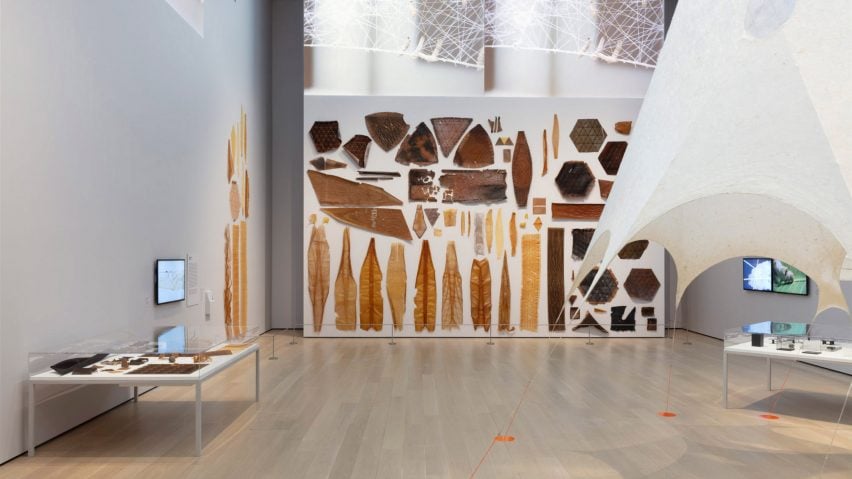New York's MoMA is staging an exhibition showcasing Neri Oxman's research at MIT Media Lab with projects that "challenge the status quo of architectural design".
Neri Oxman: Material Ecology contains seven key projects from the American-Israeli's Mediated Matter Group research department at Massachusetts Institute of Technology (MIT).
Organised by Museum of Modern Art senior curator Paola Antonelli and curatorial assistant Anna Burckhardt, the exhibition marks the first time Oxman's work is shown as a collection.
"The significance of this exhibit for me and for my team is enormous," Oxman told Dezeen.
"Our work has developed for almost 20 years, from scientific inquiry to design exploration and vice versa," she added. "We have learned a ton."
Oxman came up with the name, Material Ecology, as a framework for understanding her work – which combines engineering, art, science and technology to explore new materialities.
"It is the definition of ecology – the branch in biology that deals with the relations between organisms and their physical surroundings – applied to all things man-made or human-designed," she said.
"Biology is far more refined and sophisticated than material practices involved in polymers, concrete, steel and glass. But what if we could change that by creating new technologies that can vary the physical properties of matter at a resolution and sophistication that approaches that of the natural world?"
Oxman said the creations, which are displayed at the MoMA exhibit alongside artefacts that demonstrate the research processes behind them, have made significant strides in the field of architecture.
"We have successfully built a body of work that enabled us to challenge the status quo of architectural design, questioning first principles associated with materials, structures, ecology and our evolving relationship with the natural environment overall," she said.
Oxman added that the exhibit comes as the team begins to shift focus from experimental projects to real-life scenarios.
"We are finally ready to tackle the next phase of our work which involves the translation and transformation of our research into real-world contexts and applications," she added.
Among the works on display is a 9.5-meter tall Silk Pavilion II. Custom-made for the show, the design is the second version of the Silk Pavilion Oxman created in 2013, and uses a new jig machine that rotates the structure every so often so silkworms keep moving across the pavilion to lay silk more evenly.
It is a hollow, stainless steel frame with knitting across it. On top of this, 17,000 silkworms have laid their silk to completely cover the structure inside and out.
According to Oxman, the research is important because it shows how traditional production of the material can be made more sustainable in the future.
"The silk pavilions demonstrate that we can produce silk goods, with relatively high levels of control over fibre-distribution, without boiling larvae alive in their cocoons," she said.
"This is significant, and we hope that this may inspire more sustainable sericulture practices in the future associated not only with silkworms but other organisms whose 'goods' are being exploited by humans, such as bees and their honey."
Another key project featured is the Aguahoja structure, which was awarded the Dezeen Awards 2019 design project of the year for demonstrating how organic, biodegradable materials could be combined to create objects on an architectural scale.
Its panels are made from biopolymers, such as cellulose and fungi tissue (chitin), formed into a compound and extruded by a robotic arm. The texture solidifies as it comes in contact with air.
The exhibition is organised chronically on the ground floor of MoMA, in a new room created as part of the museum's recent expansion designed by Diller Scofidio + Renfro.
Spanning works from 2007 until the present day, the showcase includes a number of earlier projects like 3D-printed designs injected with a mixture of substances. Among these are her Vespers masks and Totems structures that show how natural materials such as human hair, melanin and gold can be altered to create new forms.
Rounding out the exhibit are 3D-printed glass structures, which Oxman's team produced following the 2015 discovery that molten glass can be layered to make a three-dimensional object.
Neri Oxman: Material Ecology is on view from 22 February to 25 May 2020.
Oxman, who was born in Haifa, Israel in 1976, studied architecture at the Technion Israel Institute of Technology and at London's Architectural Association School of Architecture.
She moved to the US to study at MIT in 2005 and became a professor in 2010, when she also founded the university's Mediated Matter Group.
The MoMA exhibit follows a wave of interest in Oxman's work, which was among the projects in New York's Cooper Hewitt design triennial. Oxman also features in the second series of Netflix's show Abstract about the world's most innovative designers.
Photography is by Denis Doorly courtesy of the Museum of Modern Art.

